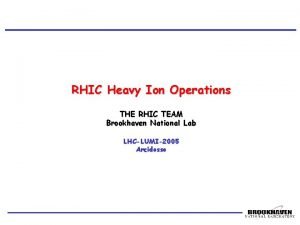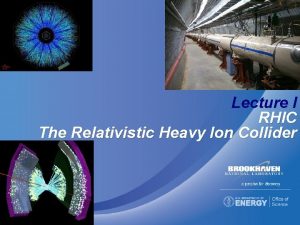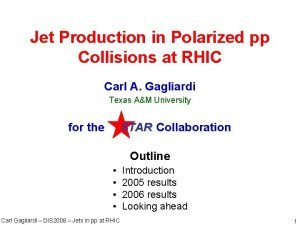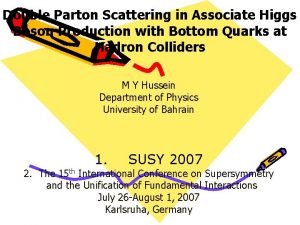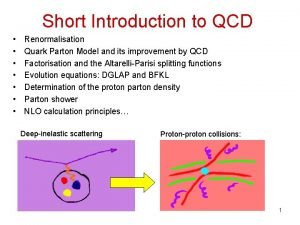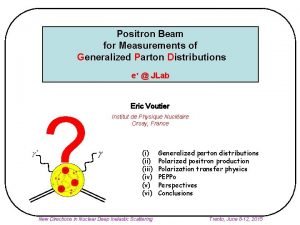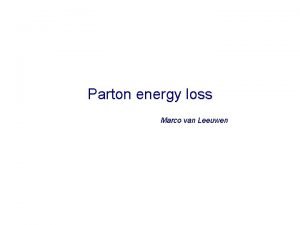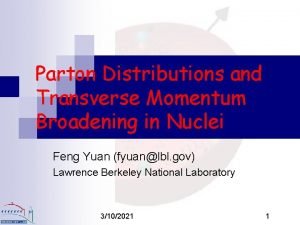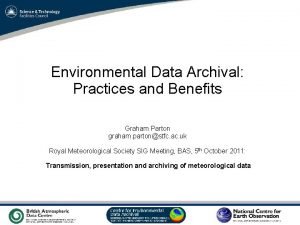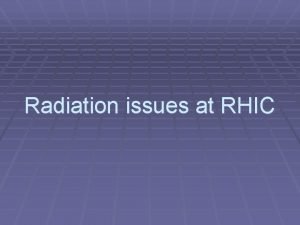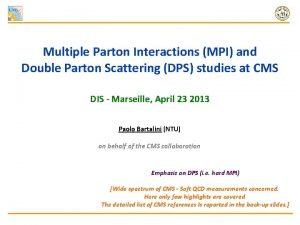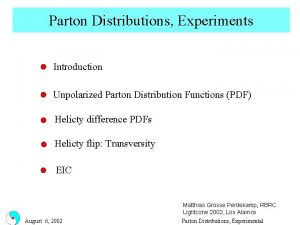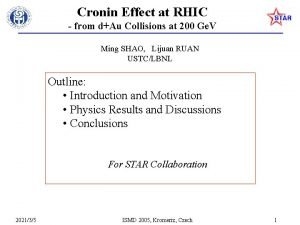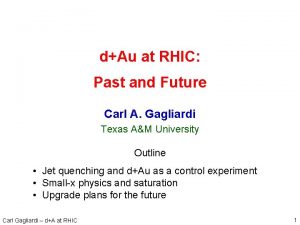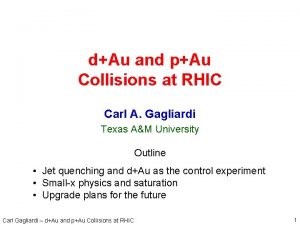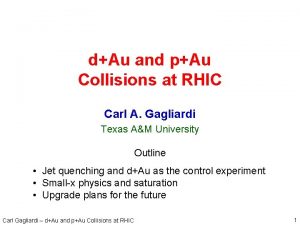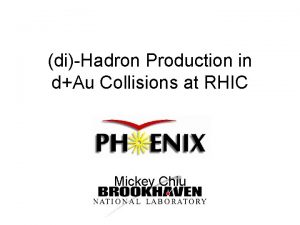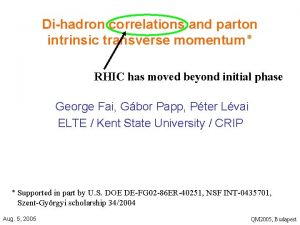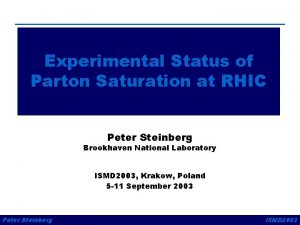New dAu RHIC data show evidence for parton















- Slides: 15

New d+Au RHIC data show evidence for parton saturation Cyrille Marquet Institut de Physique Théorique, CEA/Saclay

Outline • Introduction to parton saturation - the hadronic/nuclear wave function at small-x - non-linear parton evolution in QCD - the saturation scale and the unintegrated gluon distribution • Particle production in d+Au collisions at forward rapidities - the suppressed production was predicted by saturation physics - recent theoretical progress and new NLO predictions • Two-particle correlations at forward rapidities - sensitive to multi-parton distributions - correlations in azimuthal angle show that monojets are produced

Parton saturation x : parton longitudinal momentum fraction k. T : parton transverse momentum the distribution of partons as a function of x and k. T : QCD linear evolutions: DGLAP evolution to larger k. T (and a more dilute hadron) BFKL evolution to smaller x (and denser hadron) dilute/dense separation characterized by the saturation scale Qs(x) QCD non-linear evolution: meaning gluon density per unit area it grows with decreasing x recombination cross-section recombinations important when the saturation regime: for with this regime is non-linear yet weakly coupled

Single particle production at forward rapidities

Forward particle production • forward rapidities probe small values of x k. T , y transverse momentum k. T, rapidity y > 0 values of x probed in the process: the large-x hadron should be described by standard leading-twist parton distributions the cross-section: the small-x hadron/nucleus should be described by a Color Glass Condensate single gluon production probes only the (unintegrated) gluon distribution

The non-linear QCD evolution • the unintegrated gluon distribution Balitsky-Kovchegov x evolution • BK equation in coordinate space this is a leading-order equation in which the coupling doesn’t run • modeling the unintegrated gluon distribution before now the numerical solution of the BK equation is not useful for phenomenology (because this is a leading-order calculation) instead, saturation models are used for (with a few parameters adjusted to reproduce the data) BK evolution at NLO has been calculated Balitsky-Chirilli (2008) one should obtain from the evolution equation

BK evolution at NLO • running coupling (RC) corrections to the BK equation taken into account by the substitution Kovchegov Weigert Balitsky (2007) RC corrections represent most of the NLO contribution • the begining of saturation phenomenology at NLO first numerical solution Albacete and Kovchegov (2007) first phenomenological implementation Albacete, Armesto, Milhano and Salgado (2009) to successfully describe the proton structure function F 2 at small x

NLO-BK description of d+Au data Albacete and C. M. (2010) the shapes and normalizations are well reproduced, except the 0 normalization the speed of the x evolution and of the p. T decrease are now predicted this fixes the two parameters of theory: - the value of x at which one starts to trust (and therefore use) the CGC description - and the saturation scale at that value of x in very forward particle production in p+p collisions at RHIC (where NLO DGLAP fails), using this formalism to describe the (small-x) proton also works Betemps, Goncalves, de Santana Amaral (2009)

Two-particle correlations at forward rapidities

Final-state kinematics final state : • the ideal situation two hadrons close in rapidity both in the same forward direction C. M. (2007) at forward rapidities in order to probe small x xp ~ 1, x. A << 1 • a good test for theory the saturation regime is better probed compared to single particle production is sensitive to multi-parton distributions, and not only to the gluon distribution

Azimuthal correlations in p+p typical measurement in p+p collisions at RHIC: coincidence probability Df=0 (near side) Df= (away side) at RHIC this is done with low-p. T pions (rad) a measurement sensitive to possible modifications of the back-to-back emission pattern in a hard process

No back-to-back pattern in d+Au • in central collisions where Qs is the biggest there is a very good agreement of the saturation predictions with STAR data • an offset is needed to account for the background the focus is on the away-side peak where non-linearities have the biggest effect to calculate the near-side peak, one needs di-pion fragmentation functions suppressed away-side peak standard (DGLAP-like) QCD calculations cannot reproduce this

The centrality dependence it can be estimated by modifying the initial condition for NLO-BK evolution for a given impact parameter, the initial saturation scale used is peripheral collisions are like p+p collisions the away-side peak is reappearing when decreasing the centrality no data yet, but hopefully soon

The p. T dependence with higher p. T, one goes away from the saturation regime the away-side peak is restored at higher p. T so far, only p+p data have been shown

Conclusions • Single particle production at forward rapidities in d+Au collisions - the suppressed production at forward rapidities was predicted - there is a good agreement with saturation calculations - now that NLO-BK is known, one should stop using models • Two-particle correlations at forward rapidities - probe theory deeper than single particle measurements - mono-jets seen in central d+Au collisions - first theory(CGC)/data comparison successful, more coming • Can p+p(Pb) collisions at the LHC see these saturation effects ? - need p. T ~ Qs, so maybe jets cannot be used - particle identification at forward rapidities would be good
